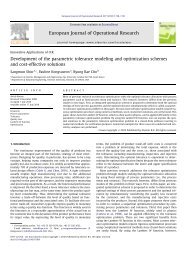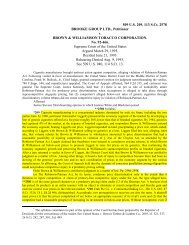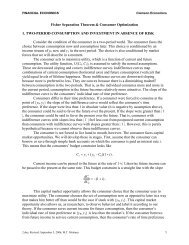A comparative discrete-dislocation/nonlocal crystal-plasticity
A comparative discrete-dislocation/nonlocal crystal-plasticity
A comparative discrete-dislocation/nonlocal crystal-plasticity
Create successful ePaper yourself
Turn your PDF publications into a flip-book with our unique Google optimized e-Paper software.
typeset2:/sco3/jobs1/ELSEVIER/msa/week.17/Pmsa15088y.001 Wed May 16 07:53:37 2001 Page Wed<br />
D. Columbus, M. Grujicic / Materials Science and Engineering A000 (2001) 000–000 15<br />
<strong>crystal</strong>-<strong>plasticity</strong> analysis. This finding can be attributed<br />
to the aforementioned less pronounced role of the<br />
<strong>nonlocal</strong> effects in the Model-II analysis.<br />
The crack profile, in Fig. 8c, is more blunted in<br />
comparison to that for Model-I, Fig. 6c. This is another<br />
indication of the less pronounced role of <strong>nonlocal</strong><br />
<strong>crystal</strong>-<strong>plasticity</strong> effects in the former case.<br />
Above, results shown in Fig. 6 and Fig. 8 were used<br />
to compare the corresponding fields and deformed finite<br />
element meshes from Model-I and Model-II <strong>crystal</strong><strong>plasticity</strong><br />
analyses at the respective onsets of crack<br />
extension. Therefore, the K I/K I0 values where different<br />
in the two cases. The results shown in Fig. 9a–c are<br />
used to show the effect of <strong>nonlocal</strong> <strong>crystal</strong>-<strong>plasticity</strong><br />
parameters at the same level of K I/K I0. That is, the<br />
results shown in Fig. 9a–c are obtained using the<br />
Model-I <strong>crystal</strong>-<strong>plasticity</strong> analysis at a level of the stress<br />
intensity factor of 1.53 (level of K I/K I0 at which crack<br />
advance begins for the Model-II analysis).<br />
The equivalent plastic strain distribution results<br />
shown in Fig. 9a can be summarized as follows:<br />
1. The deformation band associated with the =60°<br />
slip system broadens as the crack extends. Band<br />
broadening takes place mainly in the direction of<br />
crack extension.<br />
2. The highest plastic strain region remains removed<br />
from the crack tip, while the plastic deformation<br />
band as a whole, expands and increases in<br />
magnitude.<br />
3. The region just ahead of the crack tip is characterized<br />
by low plastic strain values. It appears that the<br />
crack tip is advancing into an elastic region.<br />
The normal, 22, stress contour plot shown in Fig. 9b<br />
indicates that the stress field possesses the same basic<br />
features previously identified in Fig. 6b, Fig. 7b, and<br />
Fig. 8b. The new feature of the stress field shown in<br />
Fig. 9b is the lateral movement of the region of maximum<br />
tensile stress with the crack tip.<br />
The deformed mesh shown in Fig. 9c, as well as the<br />
one shown in Fig. 7c indicate that the crack profile<br />
remains sharp as it advances. Again, no well-defined<br />
deformation bands can be observed.<br />
3.3. Comparison of <strong>discrete</strong>-<strong>dislocation</strong> and<br />
<strong>crystal</strong>-<strong>plasticity</strong> analyses<br />
A comparison of the corresponding results shown in<br />
Figs. 3–9 suggests that the <strong>dislocation</strong>/plastic strain<br />
and 22 stress fields as well as distorted finite element<br />
meshes and crack profiles obtained using the <strong>discrete</strong><strong>dislocation</strong><br />
and <strong>crystal</strong>-<strong>plasticity</strong> analyses are quite<br />
comparable. Nevertheless, some significant differences<br />
can be identified:<br />
1. the 22 stress fields, which in both analyses consists<br />
of three well defined regions, can be locally very<br />
different due to the ˜ 22 stress contribution in the<br />
<strong>discrete</strong>-<strong>dislocation</strong> analysis. This is particularly<br />
pronounced within the two deformation bands emanating<br />
from the crack tip region which contain high<br />
densities of <strong>dislocation</strong>s;<br />
UNCORRECTED PROOF<br />
Fig. 9. (a) The equivalent plastic strain contour plot; (b) the 22 stress<br />
contour plot and (c) the deformed finite element mesh for the<br />
<strong>nonlocal</strong> <strong>crystal</strong> <strong>plasticity</strong> (Model-I) analysis at the normalized stress<br />
intensity factor KI/KI0=1.53 (arrows indicate position of crack tip).
















